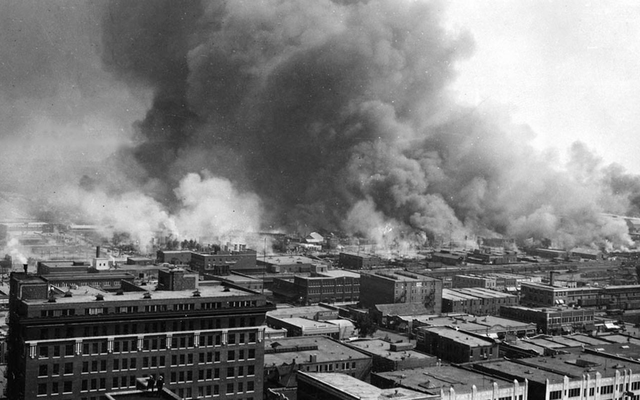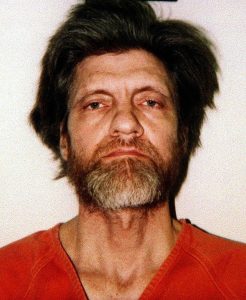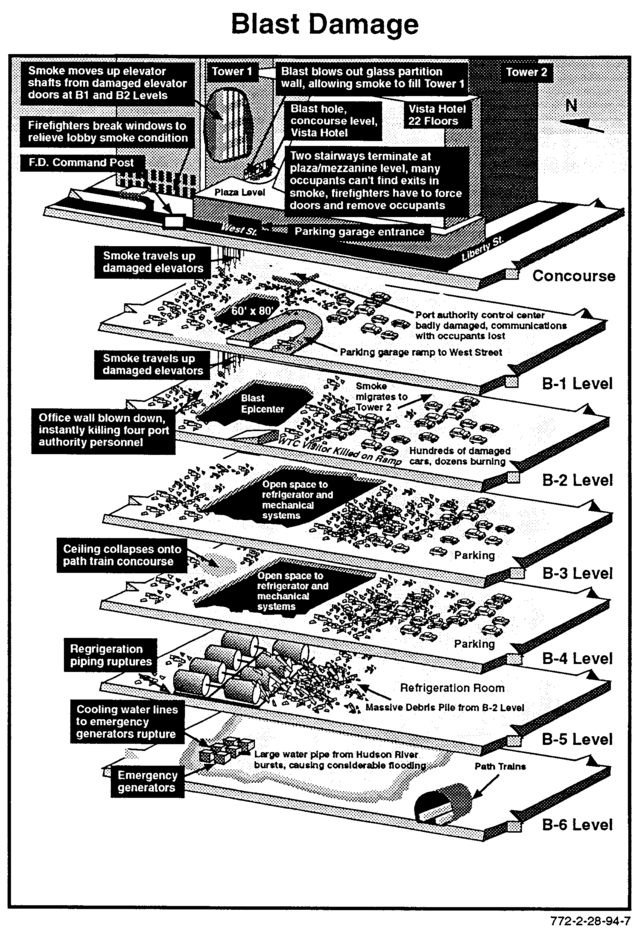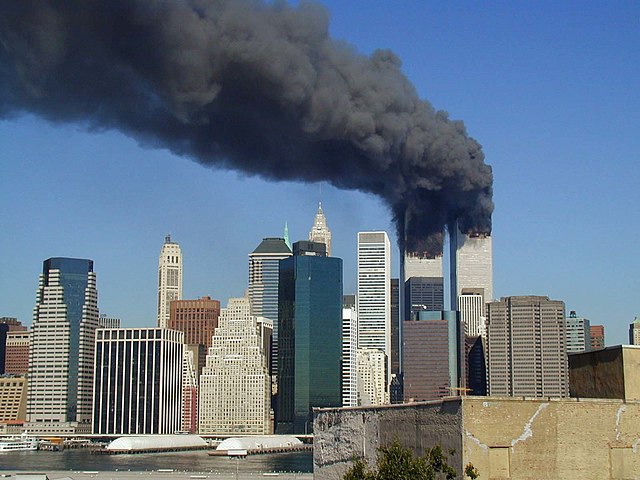10.6 Current Issues: Terrorism in America
Brandon Hamann

Contrary to popular belief, terrorism in the United States did not begin with the catastrophic events of September 11, 2001. Needless to say, the downing of the World Trade Center Towers in New York City will be forever ingrained in the memories of Americans forever. However, there have been many events that foreshadowed this one incident that were just as memorable, if not more so. Before we get into further detail, it is important that we give a bit of context into the history of Terrorism and its impact on current issues within the Criminal Justice System in the United States, because the United States has had such a unique relationship with the term “terrorism.” And what the graphic above shows is that not all acts of terrorism come from foreign adversaries. Much of it is born right here inside the United States.
What is Terrorism?
“Terrorism” is an extremely difficult word to define. It really depends on which side of the argument you are on in how you would describe its meaning. Have you ever heard the phrase “one person’s trash is another person’s treasure?” When discussing terrorism, the phrase can be reinterpreted as “one person’s freedom fighter is another person’s terrorist.” For example:
Star Wars

A small group of rebels have banded together in an alliance to fight back against the tyranny of the Galactic Emperor and his powerful Sith Lord Vader to rid the galaxy of their evil and win freedom for their friends and families and bring peace and democracy to the people.
- If you’re a supporter of the Rebels, you see them as Freedom Fighters, fighting against the Evil Empire.
- If you’re a supporter of the Empire, you see the Rebels as Terrorists, usurpers trying to change your comfortable way of life.
This is an oversimplification of an age-old story plot. However, when discussing terrorism, it can get much more complex.
For the purposes of this Introductory text, a generalized definition of terrorism is the best course. Therefore, terrorism is the unlawful use of violence and intimidation, especially against civilians, in the pursuit of political gains.
A Brief History of Terrorism in America
If we were to have a serious global historical discussion about terrorism, this textbook would be very long. In fact, there are entire courses dedicated to the study of Terrorism and Counterterrorism at the college level if you choose to pursue a career in that field. We would have to go back to before the creation of the United States to even before the journey of Christopher Columbus. However, we will keep the historical context in America to the 20th century until the present.
The Milwaukee Police Department Bombing (1917)
Italian anarchists protesting against the conscription of men into World War I unintentionally detonated an improvised explosive device inside the Milwaukee, Wisconsin Police Department, killing 9. The bomb was meant to be set off inside a nearby church, where a local priest was campaigning for the war effort (Esmail, Eargle, and Hamann, 2021).
The Tulsa Race Riots (1921)

Greenwood, Oklahoma, a suburb of Tulsa, is burned to the ground when an angry mob of white residents descend upon the majority black community after a black man is accused of assaulting a white woman. The area at the time was known as “Black Wall Street” because of the affluence of the black-owned businesses that made up the neighborhood (Esmail, Eargle, and Hamann, 2021).
The Unabomber (1978-1995)


Theodore “Ted” Kaczynski, a noted Harvard educated mathematician and engineer, terrorized the country by sending homemade letter bombs through the mail. It was only after family members recognized his writing style from a manifesto Kaczynski had sent to media outlets that he was apprehended in a small log cabin in rural Montana. Ted Kaczynski took his own life while in prison in June 2023 (Esmail, Eargle, and Hamann, 2021).
World Trade Center Bombing (1993)

Believe it or not, the events of September 11 were not the first time the World Trade Center Towers were the victim of a terrorist attack. In the early morning of February 26, 1993, a moving van loaded with a chemical mixture of fuel and fertilizer was detonated in the parking garage of the North Tower. Six were killed, and over 1000 people were injured in the blast. Ramzi Yousef, a member of an international terrorist group called al-Qaeda, was tried and convicted with 5 other co-conspirators (Law, 2016).
The Branch Davidians (1993)

Fearing that a group of Christian Fundamentalists called The Branch Davidians were stockpiling illegal weapons and maintaining a meth lab inside their Waco, Texas compound, the ATF and DEA attempted to execute a search warrant on February 28, 1993. Fifty-one days later, 82 members of the Branch Davidian group, including men, women, and children, and multiple federal law enforcement officers, had been killed during a lengthy standoff that ended in a fire that consumed the building where the leader, David Koresh, had been hiding out.
The Oklahoma City Bombing (1995)

In retaliation for the disaster at Waco, among others, two American extremists, Timothy McVeigh and Terry Nichols, detonated an improvised explosive device in front of the FBI building in Oklahoma City, Oklahoma, on April 19, 1995. The explosion killed 168, including children who were attending childcare services for federal employees working in the office building.
Atlanta Olympics Bombing (1996)
During the 1996 Summer Olympics in Atlanta, Georgia, a pipe bomb exploded in Olympic Park, killing 2 and injuring 111. Initially, the FBI had alleged the perpetrator to be a security guard, Richard Jewell, and made every attempt to discredit him in an attempt to get him to confess. Jewell was later exonerated when, in 2003, Eric Rudolph was arrested after a lengthy manhunt for the bombing of an abortion clinic in Alabama, Atlanta, and the bombing of a gay nightclub.
World Trade Center Towers (September 11, 2001)

After failing in 1993 to take down the World Trade Center Towers from the inside, al-Qaeda leader Osama bin Laden orchestrated a daring plot to topple the buildings from the sky. Two commercial airliners were hijacked and flown directly into Towers 1 and 2, culminating in their collapse on September 11, 2001. Additionally, a simultaneous attack was carried out against the Pentagon in Washington, D.C., when another hijacked commercial airliner was flown into it. A fourth attempt was thwarted when passengers were able to successfully subdue the terrorists and force the plane down in a field in rural Pennsylvania. Reports indicated that flight was intended for either the White House or the Capitol Building.
Domestic Terrorism
While the events of 9/11 awakened the United States to the threat of foreign terrorist attacks, there was still the issue of how the country and its criminal justice system defined domestic threats as well. Even while the country fought to avenge the destruction of the World Trade Centers on a global scale, it was wrestling with how to deal with its own homegrown problems. Terrorism in its simplistic definition does involve violence for political gain; that violence gets even more complex when other ideologies become involved, such as
- Religion
- Homophobia
- Xenophobia
- Racism
- Environmental Extremism
Since 9/11, there have been some notable domestic events that have added to the debate of just how far behind the criminal justice system is in dealing with terroristic attacks on U.S. soil by U.S. citizens. In 2015, Congress attempted to fix that by passing The Freedom Act and 18 U.S. Code 2331, both of which were instrumental in defining what domestic terrorism was (Hamann, et al., 2021). Unfortunately, neither legislation laid out the groundwork for penalties to be sanctioned on those who were convicted of crimes of domestic terrorism.
Terrorism in Louisiana
Louisiana is no stranger when it comes to terrorism. New Orleans is home to the Eastern District Federal Court, Baton Rouge is home to the Middle District Court, and Lafayette is the Western District seat. If there were ever a national case of domestic terrorism to be heard in Louisiana, it would be heard in one of these District Courts, depending on location of the incident. And there have been a number of domestic terrorism attacks in Louisiana in recent history. In 2020, a rash of church fires spread across the state. Anti-semitic slurs and white supremacist symbology were found at the scene. Four churches within a 200 mile radius were burned. All four churches were historically black congregations. No suspects have ever been found.
In order to fight global terrorism, the United States government began a counterterrorism campaign that included a war effort against al-Qaeda and the countries alleged to have given them financial support and shelter. This brought the United States into conflict with Afghanistan and Iraq. Ultimately, these campaigns led to the deaths of both the leaders of al-Qaeda, Osama bin Laden and Saddam Hussein, the militant dictator of Iraq. However, by the end of 2017, those war efforts had cost the United States approximately $2.8 trillion dollars (stimson.org).
Domestically, since 9/11, the United States has continuously increased its spending on counterterrorism efforts domestically. President George W. Bush created the Department of Homeland Security in 2002 with the expressed purpose of safeguarding the American people from domestic threats. These threats include cyber attacks, border security, and domestic terrorism in cooperation with the FBI. The Department of Justice has also been given ample budgetary monies to investigate and prosecute domestic offenders. In 2022, the Department of Justice (DOJ) budget request totaled $101.2 million for domestic terrorism threats alone. This allocation would be used for the FBI, U.S. Marshals, U.S. Attorneys, and other offices to research “domestic radicalization” (DOJ, 2022).
The Complexities of Terrorism and the U.S. Criminal Justice System
The difficulty with Terrorism with regards to the U.S. criminal justice system comes from the fact that the majority of domestic offenders are American citizens. Therefore, those who are alleged to have committed acts of violence that could be defined as “terroristic” in nature are still entitled to the same constitutional rights and privileges as everyone else. Furthermore, there is also the consideration of intent. Remember the chapter on criminological theories (chapter 2) and the determination of causation. The most difficult aspect of trying to define an act of violence as the intent, or motivation behind the event. With international terrorism, it’s a much simpler definition in most cases: an act of violence, especially against civilians, for political gain. When those acts of violence are perpetrated by citizens against civilians (Americans against Americans) but the ideologies are not consistent with a particular political agenda, then it becomes a much more complex situation than just saying it is a terroristic act.
Also recall the chapter(s) on the amendments. The Constitution of the United States of America provides every American citizen certain rights and protections. And those rights are no more important than when dealing with accusations of criminal wrongdoing. A quick reference to those Rights are:
- The First Amendment: Freedom of speech, religion, the press, peaceful protest, and assembly
- The Fourth Amendment: The right against illegal search and seizure
- The Sixth Amendment: The right to a speedy and public trial, an impartial jury, and the right to an attorney
- The Eighth Amendment: The right against excessive bail, excessive fines, and the right against cruel and unusual punishment
- The Fourteenth Amendment: Equal protection under the law (due process)
To lessen the complications of the nuances of prosecuting domestic terrorism cases within the United States, or even trying to determine what constitutes a terrorist event within its borders, the U.S. criminal justice system has devised a method of legislative and punitive alternatives that do the same job as international terrorist violations. Instead of labeling everything as a “terrorist attack,” the federal government began passing legislation to prosecute violent acts against minority groups, since most of the incidents were being investigated as such. Starting in 1968, Congress passed 18 U.S.C. §245 (Violent Interference with Federally Protected Rights), which gave the criminal justice system the power to prosecute acts of violence against Black communities and Civil Rights activists. Over the course of the next 60 years, those prosecutorial powers have been expanded to include Asian American and Pacific Island heritages, as well as members of the LGBTQ+ communities, and many religious groups. What these powers allow the U.S. criminal justice system to do is to still prosecute and punish violators the same as international terrorists while giving them a bit of flexibility within the system. The crimes are the same, the sentencing is the same, but now the distinction of the violent acts are called “Hate Crimes.” To learn more about federal hate crime laws, explore Hate crime laws, explained.
the unlawful use of violence and intimidation, especially against civilians, in the pursuit of political gains.
political or military activities designed to prevent or thwart terrorism.
the committing of terrorist acts in the perpetrator's own country against their fellow citizens.

